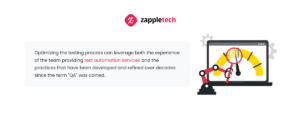According to the results of the Microfocus survey, respondents determine the approach to test automation services and their value by the following factors: Maintainability (46%), Business needs (44%), and New technology (43%).
In fact, this indicates the need for QA in developing and supporting IT solutions, regardless of their scale or niche.
The popularity of the test automation testing services industry is also evidenced by the latest analysis by GM Insights, which indicates that the segment has passed the $20 billion mark as of 2022. The CAGR is at 15%, and forecasts promise the industry will be worth more than $80 billion by the end of 2032.
It’s hard to overestimate the importance of test automation services but remember that they have more than just benefits. If you take the wrong approach to organizing the QA process, you risk not achieving your goals and blowing your budget.Mykhailo PoliarushCEO, ZappleTech Inc.
To prevent such a scenario, it is worth reading the material prepared by ZappleTech specialists, which describes the pitfalls of automation and how to level them.
Table of Contents
Overview of Test Automation Services and Their Benefits

Let’s start the analysis with the basics by considering the stages and sequence of QA processes, their importance for a digital product, and, accordingly, for the business.

When hiring experts to test your project, pay attention to the types and comprehensiveness of their services. This affects the timing of the work, its quality, and the quality of the final iteration of the IT solution.
Find out whether they only implement technical processes or whether the range of services includes analysis of the tech stack, market, target audience needs, etc. Every detail in test automation services is essential because it directly impacts your project’s competitiveness and viability.
Analyzing characteristics and defining project goals
First, you must research the future digital product, identifying its features, target audience, and business logic. This will help prioritize the IT solution’s testing, including through test automation services.
The advantages of such analytics include the following:
- A clear scope of work
- Identifying potential technical problems
- Getting an idea of the features of the future solution
- Identifying priorities for automating inspections
- Calculating the number of resources to be involved in the project
- Installing the necessary tools for work
In addition, the analysis will give the QA team (which provides test automation services) an understanding of the types and stages of tests that need to be performed to achieve the best result.
Creating a roadmap
Another critical service is the planning of the testing process. This is an integral part of test automation services, demonstrating the team’s expertise in QA operations. It is necessary to set deadlines, prepare for testing, and effectively divide it into stages.
The benefits of developing a roadmap include the following:
- Clear formation of deadlines
- Breaking down the QA process into stages
- Accounting for potential schedule shifts
- Calculating the necessary number of experts to involve
- Forming teams to work on project elements
- Preparing the necessary resources and infrastructure before starting work
A roadmap allows for setting priorities for test automation framework each QA stage and monitoring the progress of test automation services’ goals.
Developing test cases and preparing the work environment
The actual QA process begins even before the project development starts. This is facilitated by the preliminary stages functional testing, especially analysis.
The testing team creates test cases for initial checks, eventually transforming them into algorithms necessary to provide the client with comprehensive test automation services.
The benefits of early test scenario development include the following:
- The ability to create code that will later be used for automation
- Considering the specifications of the digital product
- Fine-tuning tools and testing environments more accurately
- Adapting test cases to critical process needs
- Integrating operational platforms into CI/CD systems
- Accelerating the launch of testing processes
This allows for continuous testing by deploying test automation services in the early stages of project development. Moreover, it enables testing the concept and specifications even before creating the first lines of code.
Starting key processes with test automation services
Writing test cases, conducting manual testing, and documenting results. This cycle repeats throughout the entire QA process, from its initiation to the delivery of the final iteration of the IT solution to the client. This process can be accelerated through automation, specifically test automation services, but it doesn’t eliminate manual checks.
The significance of the QA process for a digital product includes the following:
- Rapid detection and localization of bugs
- Accelerated development through continuous quality control
- Improvement of the technical state of the IT solution at each stage of its creation
- Reducing the risk of problems penetrating the final iteration of the project
- Enhanced chances of early launch and product ROI conversion
- Adherence to client requirements, business logic, and alignment with the needs of the target audience
This stage encompasses test coverage of all testing types (and phases), from modular (test automation services) to end-to-end testing.
Final checks and preparation for project delivery
When most bugs have been fixed, the development process enters the final polishing stage, which marks a new phase for QA experts. Specifically, it involves creating technical documentation, documenting processes and their results, and generating reports for the client regarding the provided test automation services.
The importance of this stage includes the following:
- Providing comprehensive information about the technical state of the product to the client
- Describing the operations during which issues were identified and localized
- Highlighting areas where bugs may occur during operation
- Preparing technical documentation
- Creating instructions for the product’s target audience and support team
- Calculating potential ROI, conversion rates, and more
During the report generation, there is also a manual verification of all elements, which is an integral part of test automation services, at least within the ZappleTech team.
Support
You’re mistaken if you think test automation services end with checks during software development. Typically, the QA team oversees the project throughout the entire lifecycle of the IT product. There are exceptions when clients hire freelancers for support tasks, but this is rare.
The benefits of having initial project implementers provide ongoing support include the following:
- In-depth knowledge of the peculiarities of the IT solution
- Experience in developing and testing the specific product
- Understanding the principles of the software’s operation and behavior
- Maintaining the digital resource in an up-to-date state
- Regular checks on security protocols, performance, and APIs
- Possible assistance for teams scaling the project
That’s why we advise hiring professionals who can continuously provide comprehensive QA automation testing solutions and services, involving them not only in testing but also in supporting the digital product.
Common Pitfalls Associated With Test Automation Services

Despite the widespread belief that test automation services cover all the QA needs while developing or maintaining a digital product, it’s not entirely true. This is primarily due to several nuances that hinder full test automation solutions or diminish its effectiveness.
Key factors that negatively impact automation include the following:
- Lack of experience among project implementers
- Inefficient approach to service implementation
- Attempts to automate everything at once
- Weak understanding of the project type, its goals, and the needs of the target audience
- Neglecting basic work planning and scalability
These factors can lead to a complete failure of the QA role and test automation services in a specific project. In other words, the digital product’s final iteration will have technical and logical issues. These issues will harm the conversion of the IT solution and its viability in the target market.
Poor planning and strategy
When a team providing test automation services lacks sufficient (commercial) experience in the industry, they often focus heavily on the QA process but overlook the planning stage. This leads to a situation where, at a certain point, the process reaches a dead end, or confusion arises regarding its organization.
As a result, your project finds itself in a risky zone, as some potentially dangerous bugs may be missed or mistakenly ignored.
The key task of planning is to identify and incorporate priorities into the roadmap for test automation automation testing services, that are critical for the competitiveness and viability of the digital solution. This will help properly organize the QA process and foresee potential issues to respond to them promptly.
Lack of expertise and experience
When hiring a team that offers test automation services, make sure its members have experience implementing your type automation testing company side of project.
The fact is that most startups do not have commercial experience. This is a significant drawback, especially if you can’t afford to change deadlines or sacrifice software quality.
You need at least 3-5 years of experience in manual testing and programming for commercial projects to automate checks.
The same applies to the tech side of QA. If the contractor does not practice using modern testing tools, frameworks, and techniques, they cannot provide a range of test automation services quickly and efficiently. You will waste your time and money when you could hire test automation engineers from ZappleTech from the start.
Overreliance on automation
You are offered test automation services that claim to cover 100% of your digital product’s development and QA needs. However, you receive a service that doesn’t match the test data provider’s claims. This is because attempting to automate every single test 100% is both impractical and impossible.
Only a smart combination of manual and automated testing ensures a satisfactory level of quality for your IT solution, meets project deadlines, and provides optimal cost-effectiveness.
When describing test automation services, providers usually emphasize test automation strategy alone to assure clients of speed and quality in service delivery.
However, suppose tests are solely conducted in an automated mode. In that case, there is a risk of overlooking errors, experiencing a low pass rate, and ending up with a poorly maintained IT solution in the final iteration.
Inadequate maintenance and support
Test automation services in QA are believed to end when the project is delivered, but this is not true. If you stop periodically monitoring the quality of software testing a digital product and checking its technical condition, the system will fail at some point. This will negatively affect the viability of the IT solution and its competitiveness.
Support should be provided throughout the entire life cycle of a digital product: from the analysis and design stage to the end of its existence on the market.
Otherwise, you risk missing some critical issues that can’t be fixed even with test automation services.
Strategies for Avoiding These Pitfalls

The challenges and pitfalls in test automation services can and should be mitigated. As of 2023, at least four effective tactics exist to achieve this. Each aims to improve the QA process, both technically and organizationally.

Software, website, or web application errors result from a careless approach to test automation services and undervaluing the importance of QA. The sooner they are detected, the easier to localize and fix them.
Every issue in a digital product is an expense for the owner of the IT solution. The later it is identified, the more expensive it becomes to fix and improve the software. To avoid additional QA costs, being proactive and preparing for potential challenges in advance is essential.
Conducting thorough research and planning
Distributors of test automation services have to plan the work process. It is necessary to conduct a comprehensive analysis of the project and its features. Identify the target audience, its preferences, and needs. Familiarize yourself with the tech stack, architecture, design, interface, and UX concepts.
Only with an integrated approach to organizing the QA process is it possible to implement organic testing conditions that will improve team performance and the final quality of the project.
Usually, professionals providing comprehensive QA testing services include research and planning by default. However, newcomers or freelancers neglect this and move on to the testing process. Accordingly, this leads to the problems described in the previous section.
Hiring experienced professionals
There are thousands of companies in the QA market offering test automation services. However, not all have enough experience to implement a large-scale or technically complex project. Usually, the practical skills of teams are limited to popular toolkits test scripts and classical work methodologies. This is far from enough to ensure the quality of an IT solution.
When choosing a QA contractor for your project, pay attention to their portfolio, reviews, and commercial experience in the niche you need.
You can also prepare tasks typical for the project to test the skills and knowledge of a potential QA task implementer.
For example, the ZappleTech team has enough experience to solve testing tasks of any complexity. Moreover, all employees have gone through a thorny path in QA for almost all relevant industries.
Balancing manual and automated testing
Don’t believe those who promise to provide you with test automation services by automating 100% of your tests. This is not feasible both technically and financially.
Automated scenarios are launched only after confirming the effectiveness of each test manually. At the end of the project, the results of automation framework are also checked manually.
Focus on discussing the process with the contractor, and highlight the project priorities, QA levels, and types of checks to be automated. Do not automate single tests or operations that are faster to perform manually. This will save you resources: time and money that you will spend from the QA project budget.
Implementing a maintenance and support plan
You should agree on further cooperation at the beginning of work with the team that provides test automation services. For example, offer to include post-release support in the list of services.
This is necessary to keep the technical condition of the product up-to-date throughout its life cycle and identify and eliminate all potential problems in time.Sergey AlmyashevCOO, ZappleTech Inc.
However, if you abandon support or delegate it to external experts completely, you risk encountering unstable software performance, resulting in customer outflow.
Post-release support enables swift and secure testing of the working IT solution and its subsequent iterations (during scaling) before deployment on servers. As a result, the technical state of the product will improve, along with its conversion potential and ROI.
Best Practices for Successful Implementation of Test Automation Services

To achieve the highest efficiency level in test automation services, it is essential to carefully plan the automated testing services objectives, priorities, and scope of work. It is also crucial to align the concept and plans with the project’s QA provider and familiarize yourself with their proposals.

Optimizing the testing process can leverage both the experience of the team providing test automation services and the practices that have been developed and refined over decades since the term “QA” was coined.
These methodologies and recommendations have been formulated based on real project cases and insights from industry experts. Even professionals like ZappleTech adhere to the practices described below.
Despite their obviousness, some companies, as well as their clients, ignore these recommendations. Consequently, they encounter a range of issues that they could avoid.
Setting realistic goals and expectations
In test automation services, it is crucial to set priorities correctly and clearly define the project goals and the maximum potential of QA. This means you shouldn’t chase the “paper” neutralization of all potential project problems, as you risk missing critical bugs or delaying the product release.
Analyze typical cases, perhaps even those of competitors or top industry players. You’ll see that they focus their efforts on mitigating critical issues and fixing minor ones after the IT solution is released.Mikhail BodnarchukCDO, ZappleTech Inc.
Set realistic goals (prioritize critical components) and deadlines when ordering test automation services. For example, checking all functionality, UI and UX, correct data processing, etc. You can have test automation engineers fix delays, screen change speeds, or other minor bugs after the product is published, i.e., as part of the ongoing support program.
Ensuring proper training and communication
Typically, QA services mean working with a project implementer using an outsourcing model. This, in turn, causes several difficulties and potential problems. For example, with communication, cooperation between departments, and process control.
Integrate CI/CD tools and practices like Agile and DevOps into QA and development.
Talk to the project implementers and choose a convenient toolset for everyone. Also, discuss the frequency of meetings and their time (considering time zone differences, internal schedules, etc.). Set the maximum adjustments you can make to the project in a certain period without affecting deadlines and team productivity.
Continuously evaluating and adjusting the automation strategy
The work plan may change during development or when providing test automation services. For example, if technical problems arise that do not allow the project to continue without solving them.
You must be prepared for any scenario and be able to adapt current tasks to unforeseen circumstances.
The same goes for the QA process itself. Sometimes there are bugs you can’t localize or eliminate here and now. If they are not critical to the project, you can move them to the next stage and try to fix them later. The main thing is to change the strategy and plans in time, according to the current situation and progress.
By the way, do not forget to consult with hired specialists. Based on their experience, they can suggest a direction and methodology that will allow you to build the QA or development process and the overall project management more efficiently.
Why Come to ZappleTech for the Best Test Automation Services
Your digital product is the face of your brand. You must ensure the software undergoes proper QA to make it look excellent and attractive to your target audience (potential customers).

The combination of the test suites, automation services and manual checks ensures that your IT solution will enter the market in perfect technical condition with a modern and user-friendly UX. The competitiveness and viability of the project in your target niche also depend on this.
To ensure the most effective QA, you will need the assistance of professionals who have completed over a hundred projects, such as the experts at ZappleTech.
Order QA automation services from ZappleTech and receive the highest possible in quality assurance for your digital solution! Contact us now to get a free consultation from our leading team of experts!







